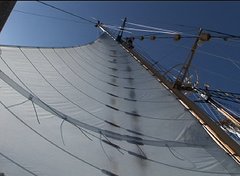
May 15. Aboard the SSV Robert C. Seamans, Pacific Ocean. The 2007 class of Stanford@SEA has made steady progress south toward the Line Islands. We're on the "Open Sea Transect Leg" and have had tremendous success. The students, professors, and crew are working 24 hours a day conducting research, sailing the ship and providing all the necessary forage for the 38 people on board.
South of the Hawaiian Islands, we've focused on the oceanography and ecology of eddy features. We crossed the center of an anticylonic downwelling eddy and clipped a piece of a cyclonic eddy. Here we studied the ecosystems of both features with Gen Del Raye, a freshman at Stanford. His project is assisting researchers at Tagging of Pacific Predators to investigate how and why large predators such as white sharks swim thousands of miles to forage in these eddies.
Sure enough, by deploying instruments that profiled the physical elements of the water column and nets that sampled the organisms living in the water, we were able to find distinct differences between the "hot" and "cold" eddy features. Also, by sending down the CTD (an instrument that measures salinity, temperature, and chemistry of the water), we were able to see that there is a significant drop in oxygen in deeper waters, which may explain why the sharks seem to dive to depths as great 1,350 to 1500 feet (450-500 meters), but quickly resurface. Water samples taken from bottles on the CTD that took samples of this deep water were also used by Annie Scofield to study changes in ocean alkalinity, in important parameter for determining oceanic uptake of carbon dioxide. -- Barb Block and Rob Dunbar, chief scientists


No comments:
Post a Comment